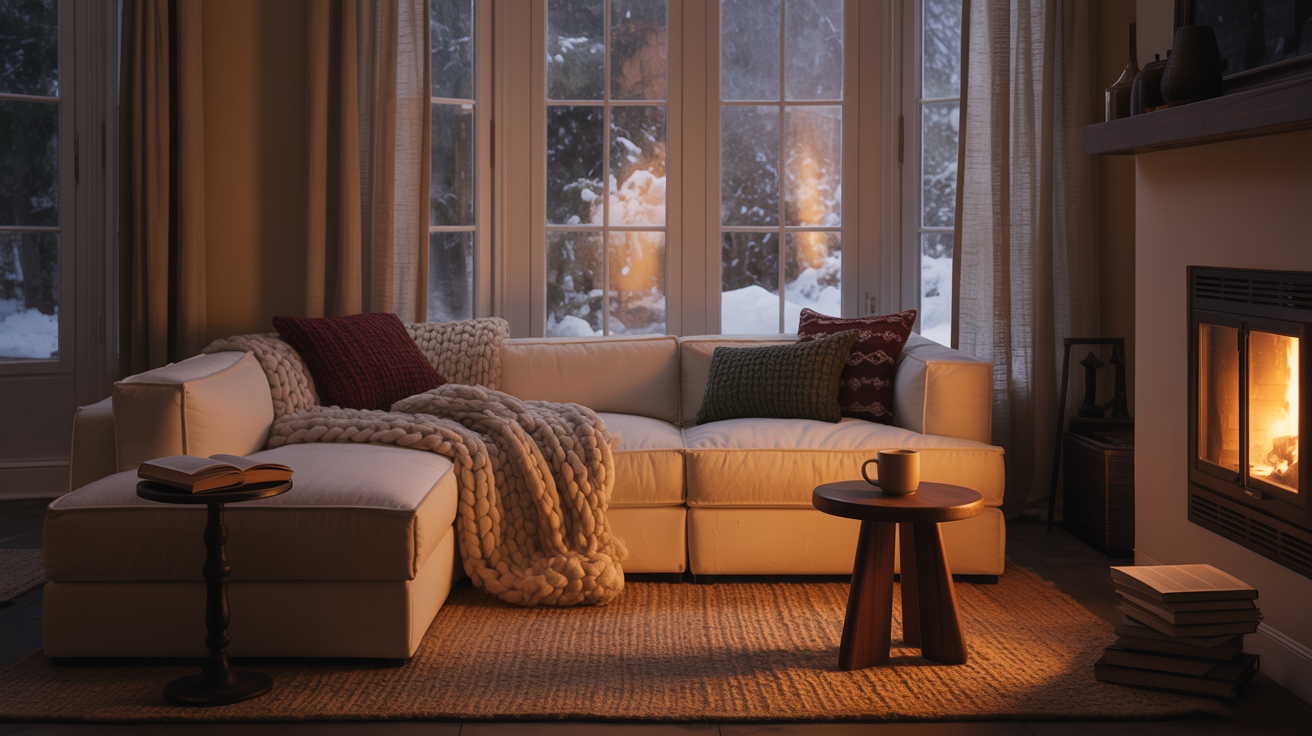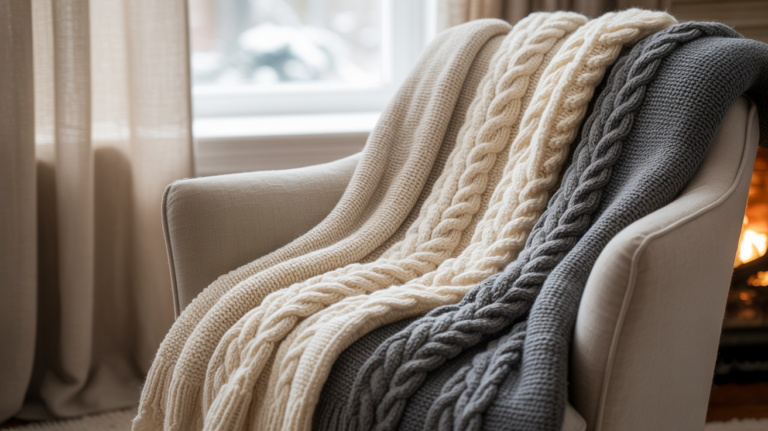As the temperature drops and days grow shorter, our living rooms become our sanctuary—a place to curl up with hot cocoa, enjoy quiet evenings, and gather with loved ones.
Creating a cozy winter living room isn’t just about aesthetics; it’s about crafting a space that nurtures comfort, warmth, and connection during the coldest months of the year.
Whether you’re transitioning from holiday decor or starting fresh for the season, this comprehensive guide will help you transform your living room into the ultimate winter retreat.
Why Cozy Winter Living Room Decor Matters
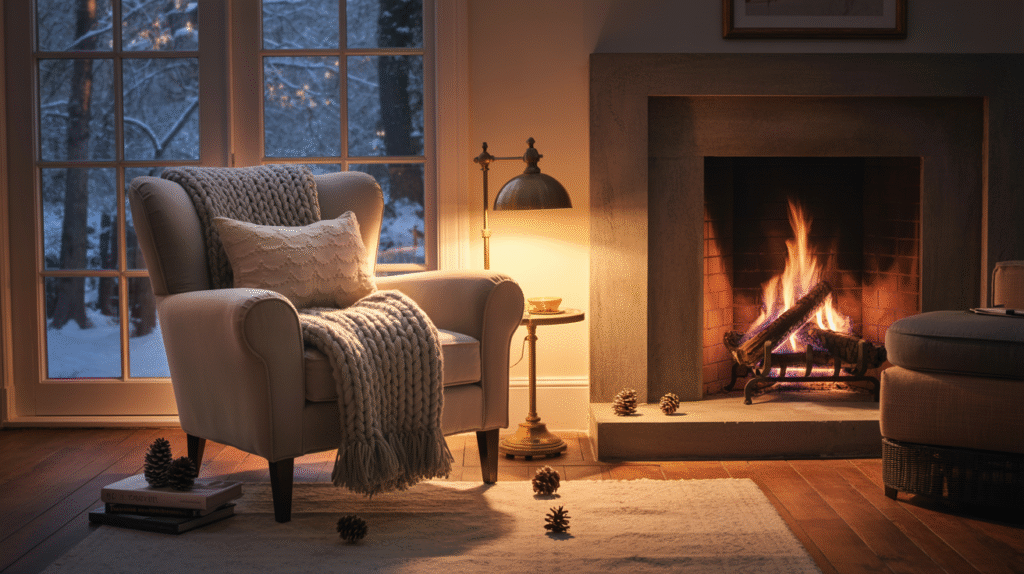
Winter decor goes far beyond simple aesthetics—it profoundly impacts our mood, energy levels, and overall well-being during the darker months.
When sunlight is scarce and temperatures plummet, our homes become our primary refuge from the elements.
A thoughtfully decorated living room can combat seasonal blues, create a sense of hygge, and make your space feel like a warm embrace after a cold day.
The psychological benefits of a cozy environment are well-documented. Soft textures trigger tactile comfort, warm lighting mimics the golden hour glow we miss in winter, and intentional design choices can make even the smallest space feel like a luxurious retreat.
Beyond personal comfort, a welcoming living room becomes the heart of winter gatherings, from intimate movie nights to holiday celebrations that extend well into January and February.
Investing time in your winter decor also encourages you to slow down and appreciate the season rather than simply endure it. When your living room feels inviting, you’re more likely to spend quality time at home, practice self-care, and create meaningful memories with family and friends.
Essential Elements of a Cozy Winter Living Room
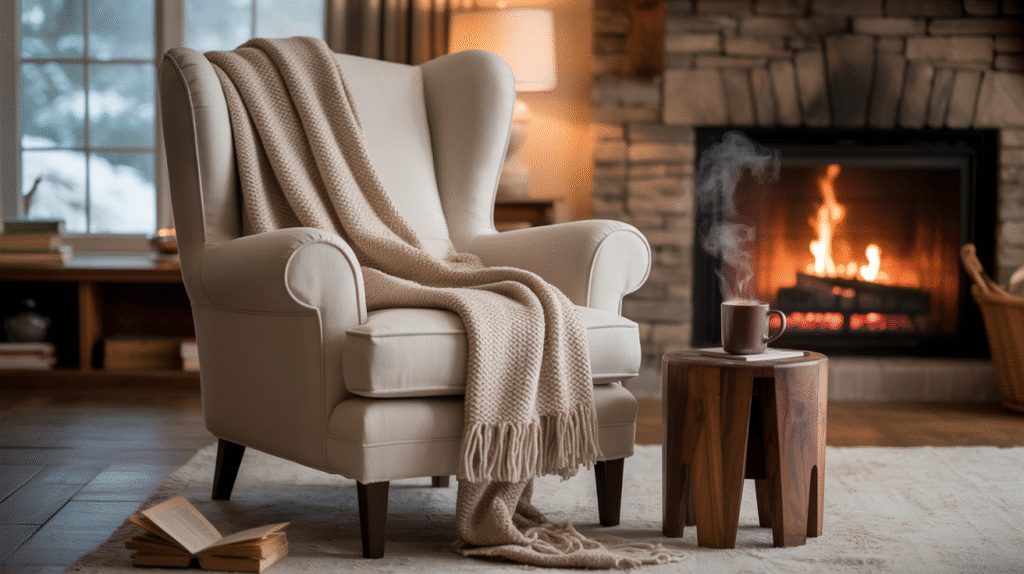
Every cozy winter living room shares certain foundational elements that work together to create that irresistible warmth. Understanding these essentials will help you make strategic choices that maximize comfort without overwhelming your space or budget.
Layered Textiles: Multiple layers of soft fabrics create both visual and physical warmth. Think chunky knit throws draped over sofas, velvet or faux fur pillows, and plush area rugs that cushion cold floors.
Warm Lighting: Overhead lights should be dimmable or avoided altogether in favor of multiple light sources at different heights—table lamps, floor lamps, and candles create a soft, ambient glow.
Natural Elements: Bringing the outdoors in with wood accents, evergreen branches, pinecones, and dried botanicals connects your space to the winter landscape while adding organic texture.
Color Warmth: Even if you prefer a neutral palette, incorporating warm undertones—creams instead of stark whites, warm grays, rust, terracotta, deep greens, or burgundy—makes a significant difference in how cozy your space feels.
Comfortable Seating: Your furniture should invite lounging. If your sofa isn’t the softest, layer it with cushions and throws to create that sink-in feeling.
Personal Touches: Family photos, beloved books, handmade items, and collected treasures make a space uniquely yours and infinitely more inviting than a showroom aesthetic.
Winter Coffee Table Decor Ideas That Feel Like Hygge
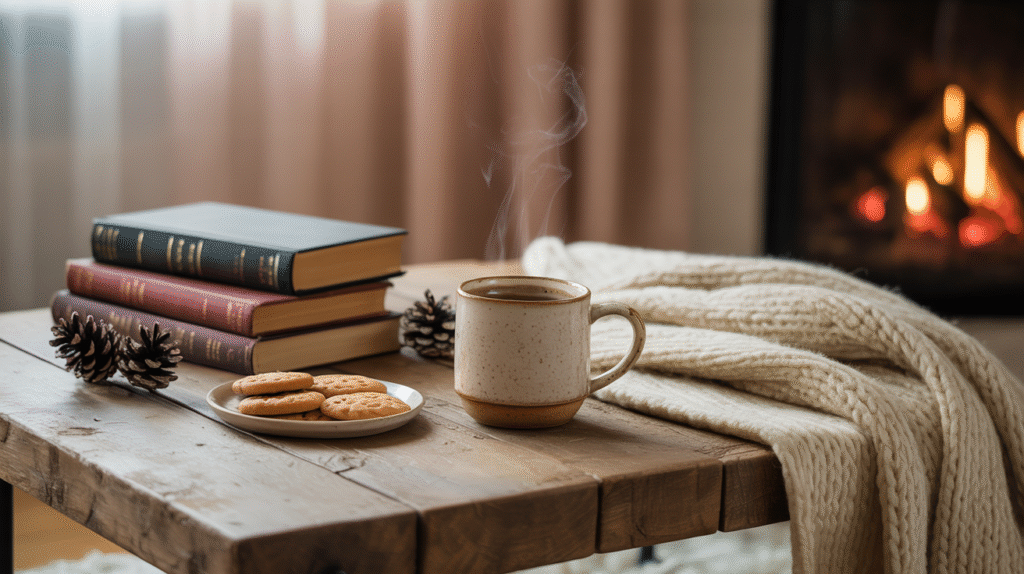
Your coffee table is prime real estate for creating a cozy focal point that’s both beautiful and functional.
The key to winter coffee table styling is embracing the Danish concept of hygge—creating intimate, cozy moments through simple pleasures.
Start with a base layer like a textured table runner, a wooden tray, or a woven placemat to anchor your arrangement.
Group candles of varying heights together—pillar candles in glass hurricanes, taper candles in brass holders, or a collection of tea lights create instant ambiance.
Choose unscented or subtle winter scents like pine, cedar, or vanilla to avoid overwhelming the space.
Add natural elements in a bowl or wooden dough bowl: pinecones, birch logs, eucalyptus branches, or seasonal fruit like pears and pomegranates. Include a small stack of your favorite books with their spines facing out, topped with a small potted plant or succulent. A beautiful mug ready for hot beverages signals invitation and hospitality.
Keep functionality in mind—leave enough clear space for actual coffee cups, remotes, and coasters. The best coffee table displays look effortlessly curated, not cluttered.
Rotate elements weekly to keep the vignette fresh: swap out greenery, change candle arrangements, or display different books based on what you’re currently reading.
Cozy Living Room Color Palettes for Winter
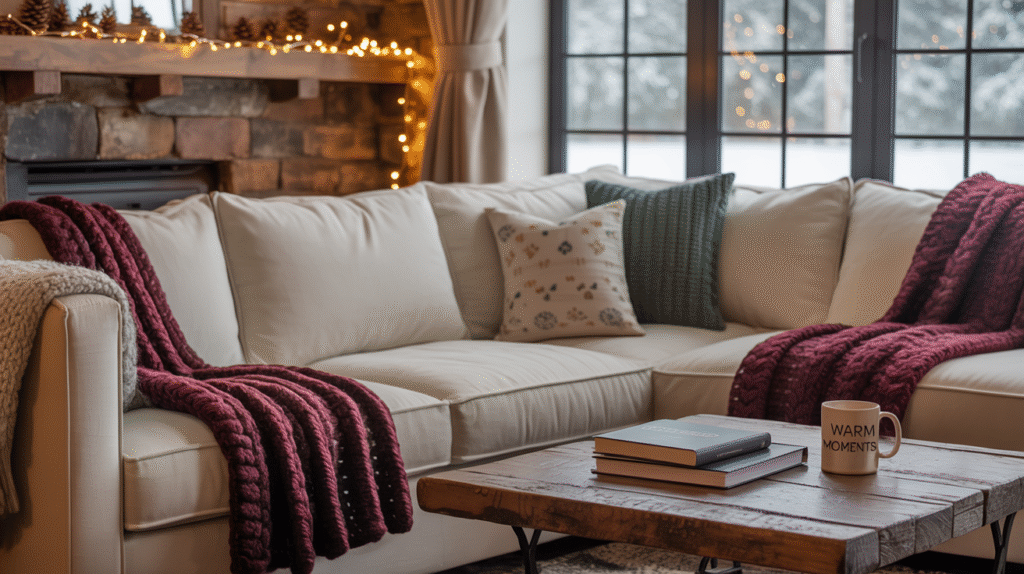
Color profoundly influences how warm and inviting your living room feels during winter months.
While you don’t need to repaint walls, incorporating the right accent colors through decor can transform the entire mood of your space.
Classic Warm Neutrals: Cream, beige, camel, warm gray, and taupe create a sophisticated, calming backdrop that works with any style. Layer different shades of the same neutral family for depth without visual chaos.
Rich Jewel Tones: Deep emerald, sapphire blue, burgundy, and amethyst add luxurious warmth and pair beautifully with metallic accents like brass and copper.
Earthy Organic: Terracotta, rust, olive green, chocolate brown, and burnt orange bring the warmth of autumn into winter and complement natural wood tones perfectly.
Modern Monochrome: Various shades of charcoal, slate, and soft black with warm white accents create a contemporary cozy aesthetic when balanced with plenty of texture.
Nordic Inspired: Soft whites and grays with touches of dusty blue, blush pink, and natural wood maintain an airy feel while still feeling winter-appropriate.
The secret to any successful winter palette is ensuring warm undertones dominate. Even if you love cool colors, choose versions with slight warmth—a gray with brown undertones rather than blue, or a blue-green rather than icy blue.
Layering Textures: Blankets, Pillows, and Rugs for Winter Warmth
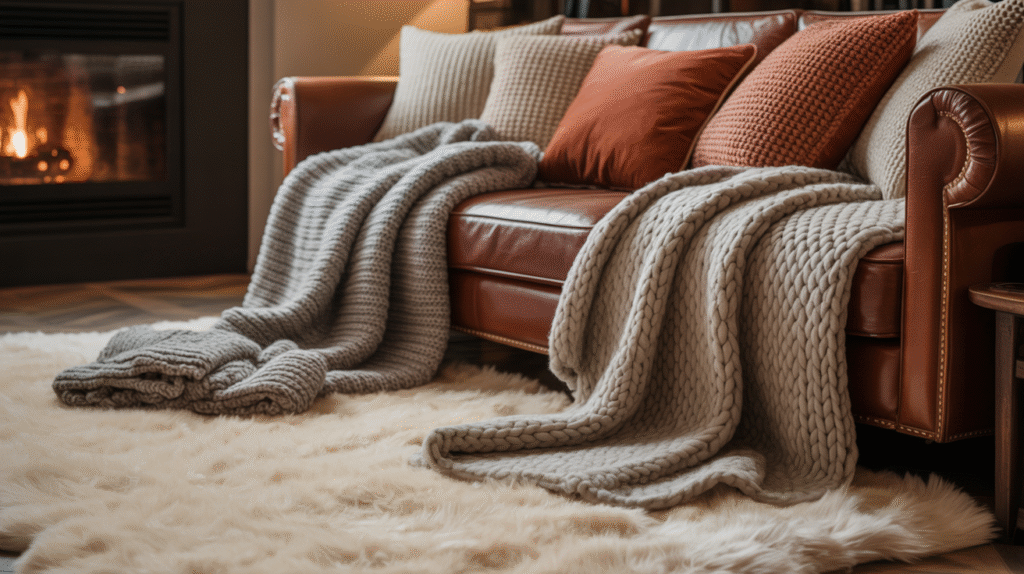
Texture is arguably the most important element in creating a cozy winter living room. Visual texture adds depth and interest, while tactile texture provides the physical comfort that makes you want to curl up and stay awhile.
Blanket Layering Strategy: Keep multiple throws in different textures accessible. Drape a chunky cable-knit blanket over your sofa arm, fold a soft fleece throw on an ottoman, and store a faux fur throw in a decorative basket nearby. This variety allows household members to choose their preferred texture and ensures you’re never without a warm layer.
Pillow Combinations: Mix pillow sizes (22-inch, 20-inch, and 18-inch) and textures for visual interest. Combine smooth velvet with chunky knits, faux fur with linen, and cable-knit with bouclé. Stick to 3-5 pillows per seating area to avoid overcrowding. Use inserts one size larger than the cover for that plump, inviting look.
Rug Layering: Layer a smaller, plush rug over a larger flatweave or jute rug to add warmth underfoot without replacing your existing foundation. A sheepskin or faux fur rug in front of the fireplace or beside the sofa creates an instant cozy zone.
Additional Texture Sources: Don’t forget woven baskets, macramé wall hangings, textured curtains, and even the grain of exposed wood furniture. Every element contributes to the overall sensory experience of your space.
Winter Lighting Ideas to Create a Warm Ambiance
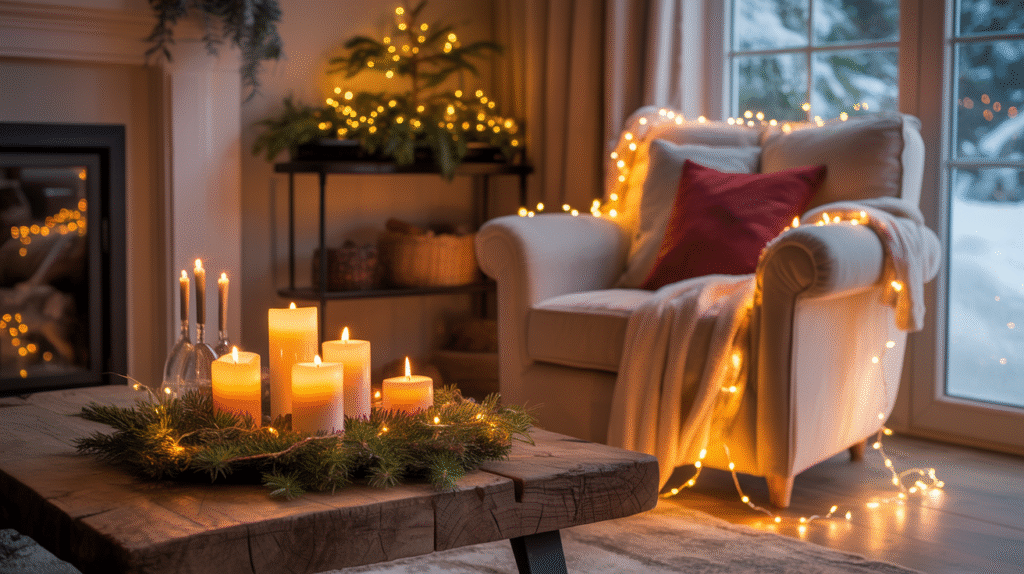
Lighting can make or break a cozy atmosphere. During winter’s long dark evenings, thoughtful lighting becomes essential for creating the warm, inviting environment you crave.
The Three-Level Lighting Rule: Incorporate ambient lighting (overhead or ceiling), task lighting (reading lamps), and accent lighting (candles, string lights) at different heights to create depth and eliminate harsh shadows.
Warm Bulb Temperature: Replace any cool-toned bulbs (5000K+) with warm white bulbs (2700-3000K). This simple switch immediately makes your space feel cozier. Look for “soft white” or “warm white” on packaging.
Candlelight is Essential: Nothing replicates the flickering warmth of real candles, but high-quality LED candles with timers work wonderfully for safety and convenience. Group candles in clusters of three or five for maximum impact.
String Lights Beyond the Holidays: Warm white string lights aren’t just for Christmas. Drape them along bookshelves, inside glass cabinets, or around window frames for a subtle twinkle that extends through winter.
Lampshade Strategy: Fabric lampshades diffuse light more softly than glass or metal. Choose cream or warm-toned shades that glow when illuminated.
Fireplace Alternatives: If you don’t have a working fireplace, consider an electric fireplace insert, a tabletop ethanol fireplace, or even a high-quality video of a crackling fire on your TV to create that mesmerizing focal point.
Natural Elements: Bringing the Outdoors Inside This Winter
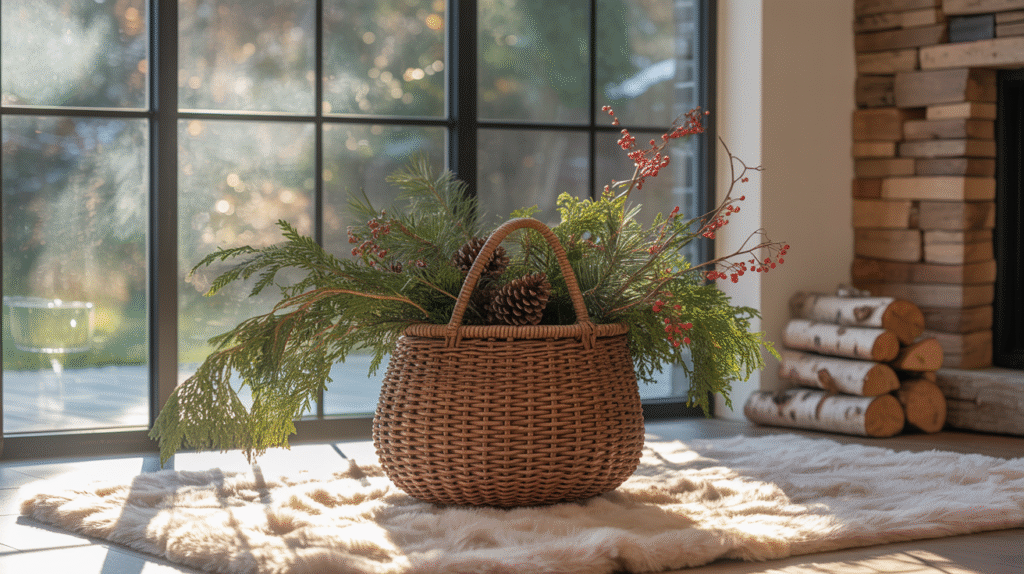
Incorporating natural elements prevents your cozy winter living room from feeling stuffy or closed off. These organic touches connect your indoor sanctuary to the beauty of the winter landscape outside.
Evergreen Branches: Pine, cedar, fir, and eucalyptus branches bring life and subtle fragrance to your space. Arrange them in tall vases, lay them along mantels, or tuck them into existing arrangements. They last for weeks and can be composted when done.
Birch Logs and Branches: Stack birch logs beside the fireplace (functional and decorative), use branches as curtain rods, or create a simple centerpiece with birch rounds. The white bark adds visual brightness to winter spaces.
Pinecones and Pods: Collect pinecones on winter walks or purchase them in bulk. Display them in wooden bowls, glass hurricanes, or scatter them on mantels. They’re free, beautiful, and quintessentially winter.
Dried Botanicals: Cotton stems, pampas grass, and dried hydrangeas maintain their beauty throughout winter. Arrange them in simple vases for low-maintenance elegance.
Living Plants: Winter is challenging for houseplants due to reduced light, but hardy varieties like pothos, snake plants, and ZZ plants thrive with minimal care and improve air quality.
Natural Fiber Baskets: Woven seagrass, rattan, or jute baskets provide storage while adding organic texture. Use them for throw blankets, magazines, or firewood.
Transitioning from Christmas to Winter Decor Seamlessly
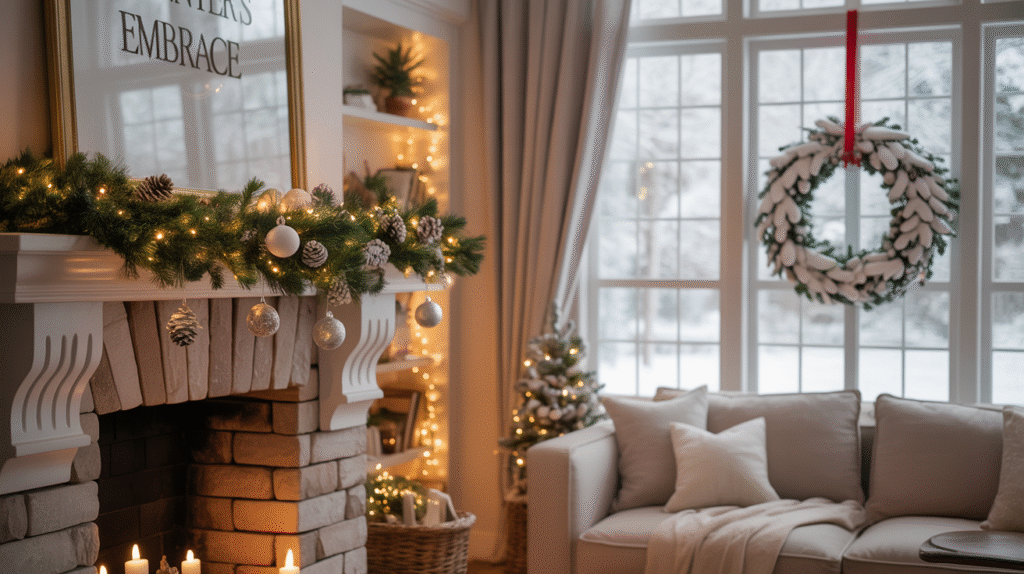
One of the biggest winter decorating challenges is the post-holiday letdown. Learning to transition gracefully from Christmas to winter decor helps you maintain a cozy, intentional space through February and March.
Remove the Obviously Festive: Pack away anything explicitly Christmas-themed—Santa figures, “Merry Christmas” signs, red and green color combinations, and holiday-specific ornaments. Keep the neutral, nature-inspired elements.
Keep Winter Whites and Naturals: White and cream decor, evergreen branches, pinecones, birch elements, and winter berries work beautifully through the entire season. You’ve already done the work—just edit out the holiday-specific items.
Introduce January-Friendly Elements: Add touches that celebrate winter itself: snowflake accents, cozy hygge themes, wintery blues and silvers, and Nordic-inspired patterns.
Simplify and Streamline: Post-holidays is an excellent time to embrace minimalism. A simpler, more curated space often feels more restful after the visual abundance of Christmas.
Celebrate the Season: Create new January and February traditions—a hot chocolate station, a reading nook focused setup, or a puzzle table—that give you reasons to maintain your cozy decor investment.
Extend Your Greenery: Replace Christmas florals with long-lasting winter options like white amaryllis, paperwhites, or forced spring branches (pussy willow, forsythia) in late winter to signal coming renewal.
Centerpiece Magic: Christmas Living Room Focal Points
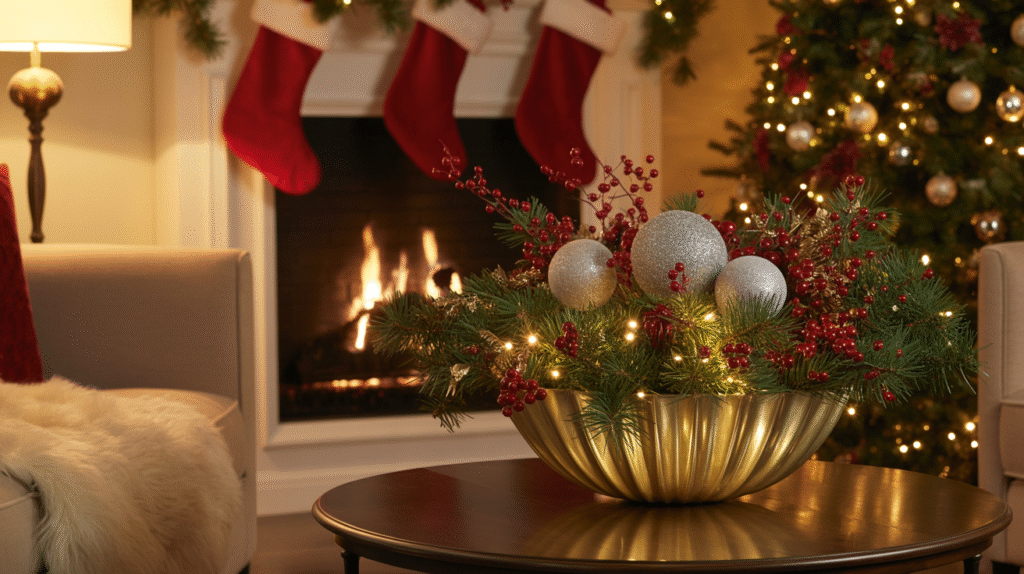
A stunning centerpiece draws the eye and anchors your living room decor scheme. Whether on a mantel, console table, or coffee table, a well-designed focal point sets the tone for your entire space.
Mantel Centerpieces: Create symmetry with matching candlesticks or lanterns on each end, then layer in varied-height elements in the center—a mirror or artwork as backdrop, garland draped across, and dimensional objects in front. Or go asymmetrical with a bold single element on one side balanced by smaller grouped items on the other.
Coffee Table Arrangements: Use the rule of thirds—divide your table into three sections and create a vignette in one or two sections, leaving space for function. Use a large tray to contain smaller items and create visual boundaries.
Console Table Displays: Layer artwork or a mirror against the wall, add a table lamp for height, and create a small vignette with books, a plant, and decorative objects. Keep it functional—this is often where keys and mail land.
Unexpected Focal Points: A decorated ladder leaning against a wall, a cozy reading chair staged as a vignette, or a beautifully styled bar cart can serve as alternative focal points.
The Power of Scale: Don’t be afraid to go big with one dramatic element—an oversized vase, a substantial piece of artwork, or a large basket of throws makes more impact than multiple small items.
Farmhouse Christmas Decor for a Rustic Cozy Vibe
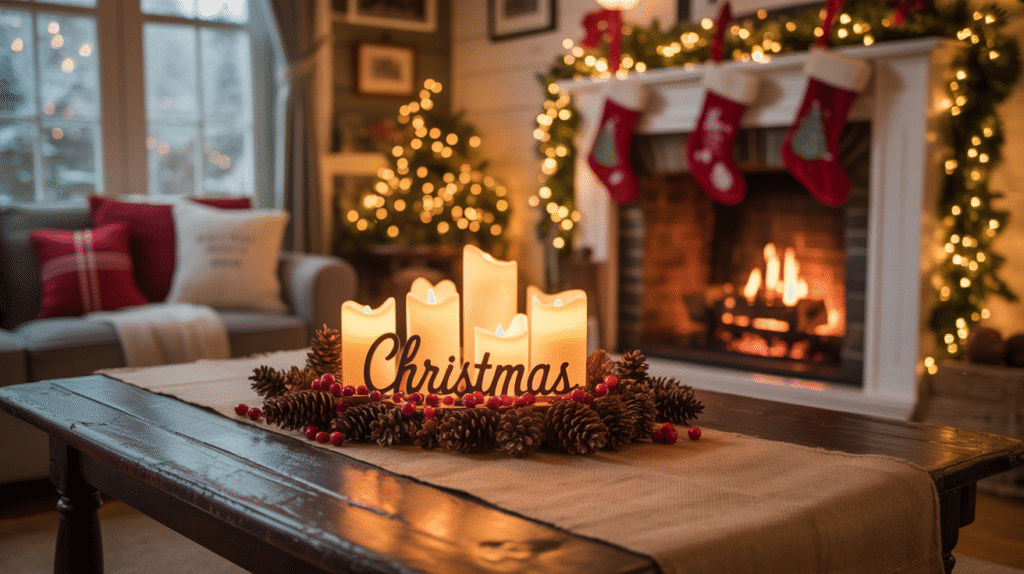
Farmhouse style naturally lends itself to cozy winter living with its emphasis on natural materials, vintage finds, and lived-in comfort. This aesthetic celebrates imperfection and creates spaces that feel collected over time rather than purchased all at once.
Signature Farmhouse Elements: Distressed wood signs with winter sayings, galvanized metal accents, vintage sleds or skates as decor, mason jars repurposed as candle holders or vases, and buffalo check patterns in black and white or red and black.
Rustic Christmas Touches: Incorporate burlap ribbons on garlands, wooden bead garlands draped on trees or mantels, plaid wool blankets, vintage-inspired ornaments in muted colors, and red truck or cabin motifs that celebrate rural winter life.
Texture is Everything: Combine smooth and rough textures—painted wood with raw wood, soft linens with rustic burlap, sleek pottery with weathered metal. This contrast is the hallmark of farmhouse style.
Fresh and Dried Florals: Farmhouse decor embraces both living and dried botanicals. Cotton stems are a winter favorite, along with eucalyptus, cedar, and dried baby’s breath.
Functional Decor: Farmhouse style doesn’t believe in decor that doesn’t serve a purpose. Decorative wooden crates store throws, vintage crocks hold utensils, and antique buckets become planters.
Modern Farmhouse Winter Decor Ideas for a Warm Living Room
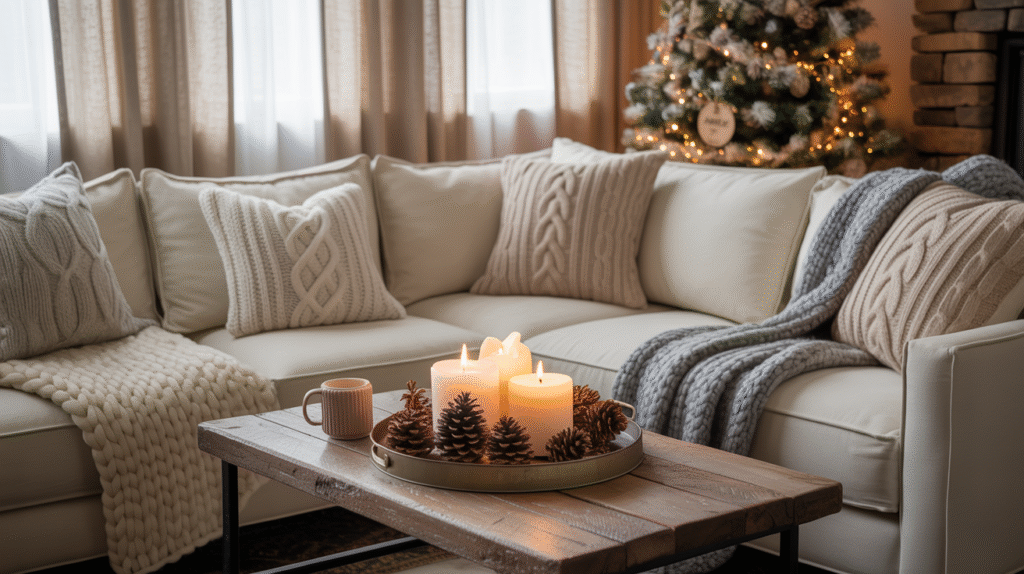
Modern farmhouse style takes traditional rustic elements and refines them with contemporary sensibilities—cleaner lines, more neutral palettes, and a slightly more curated aesthetic.
Modern Farmhouse Color Story: Stick primarily to whites, creams, grays, and blacks with subtle warm accents in camel, rust, or olive. The palette should feel cohesive and calming, not busy.
Mix Old and New: Pair a vintage wooden coffee table with a contemporary sofa, hang modern art above a reclaimed wood console, or style a sleek lamp on a rustic side table. This juxtaposition creates visual interest.
Streamlined Textures: Choose refined textures like bouclé, linen, and smooth matte finishes rather than heavy burlap or excessively distressed elements. Texture is still important but executed with more restraint.
Minimal Metal Accents: Matte black hardware, simple iron candlesticks, and clean-lined metal baskets add edge without overwhelming the warmth of natural materials.
Strategic Greenery: Rather than abundant florals, modern farmhouse style uses simple greenery—a single eucalyptus stem in a ceramic vase or a small potted olive tree.
Pattern Discipline: Limit patterns to subtle stripes, simple checks, or small-scale geometrics. The look should feel restful, not busy.
Farmhouse Winter Living Room Decor on a Budget
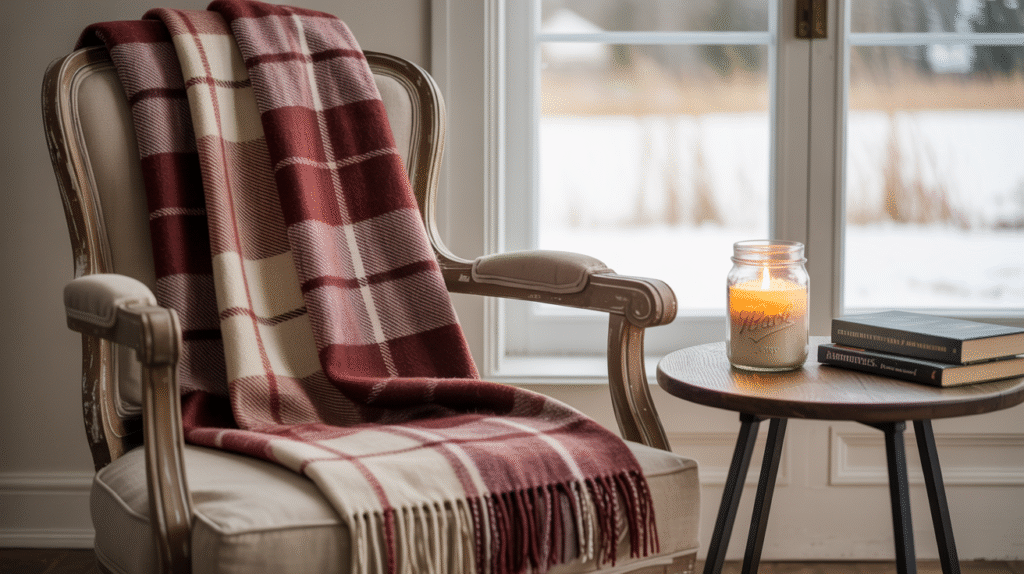
Achieving farmhouse style doesn’t require expensive renovations or designer price tags. Some of the most authentic farmhouse spaces are created with thrifted finds, DIY projects, and resourceful shopping.
Thrift and Vintage Hunt: Check local thrift stores, estate sales, and online marketplaces for vintage wooden crates, old windows, galvanized buckets, antique frames, and weathered signs. These authentic pieces have more character than new replicas.
DIY Wood Projects: Create your own chunky wood blanket ladder, floating shelves from reclaimed wood, or a simple wooden bead garland. YouTube tutorials make these projects accessible even for beginners.
Nature is Free: Forage for pinecones, evergreen clippings (where permitted), interesting branches, and stones. These cost-free elements are more authentic than purchased alternatives.
Paint Transforms Everything: A gallon of paint can farmhouse-ify anything. Paint existing furniture in whites or grays, create a faux shiplap accent wall with thin plywood strips, or give thrifted frames a cohesive look with matching paint.
Textile Investments: Splurge on one or two quality throw blankets and use less expensive pillows underneath decorative covers you can change seasonally.
Repurpose What You Have: Turn a wooden cutting board into a wall-mounted shelf, use mason jars as vases or candle holders, and display vintage books as decorative stacks.
Small Space Solutions: Cozy Winter Decor for Apartments
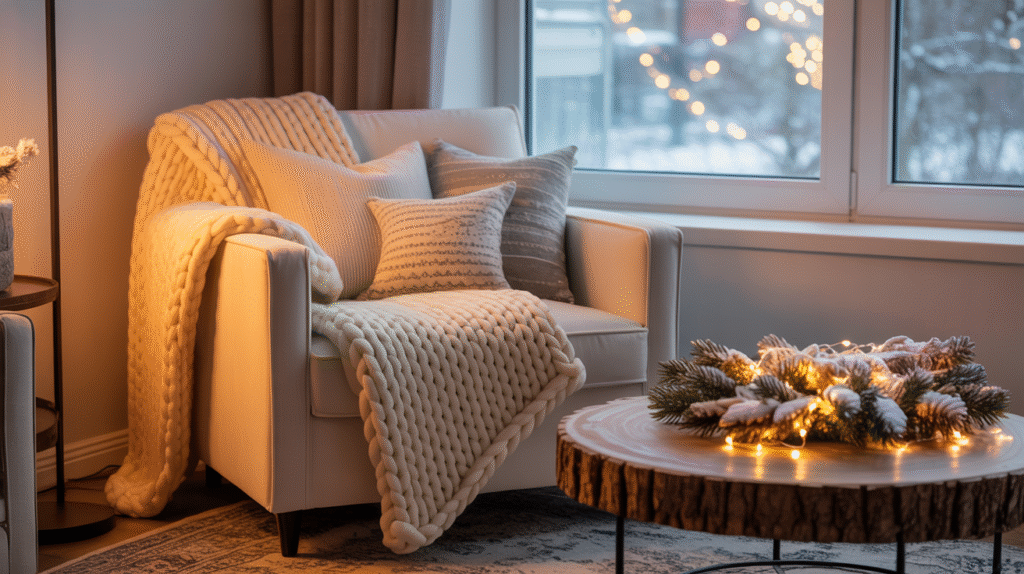
Creating a cozy winter living room in a small apartment requires strategic choices that maximize warmth without overwhelming limited square footage. The goal is to make your space feel like a cozy retreat rather than a cramped storage unit.
Vertical Thinking: Draw the eye upward with tall plants, floor-to-ceiling curtains, and wall-mounted shelves. This creates the illusion of height and makes rooms feel larger.
Multi-Functional Furniture: Choose an ottoman that provides storage and extra seating, nesting tables that tuck away when not needed, or a console that serves as both desk and display space.
Light and Bright Base: Keep walls and large furniture pieces light colored to maintain an airy feel, then layer in warmth through textiles and accessories in deeper tones.
Strategic Mirror Placement: Position mirrors across from windows to reflect natural light and create depth. A large mirror can effectively double the visual space of a small room.
Edit Ruthlessly: In small spaces, every item should earn its place. Rotate seasonal decor rather than adding to existing collections. If something new comes in, something old should go out.
Scaled-Down Decor: Choose appropriately sized accents—a small tabletop tree rather than a full-size one, a few perfect pillows rather than an oversized pile, and a single statement piece rather than multiple medium-sized items.
Create Zones: Even in a small space, define different areas—a reading nook by the window, a conversation area around a small table—to make the room feel larger and more functional.
Small Space Cozy Christmas Living Room Tips
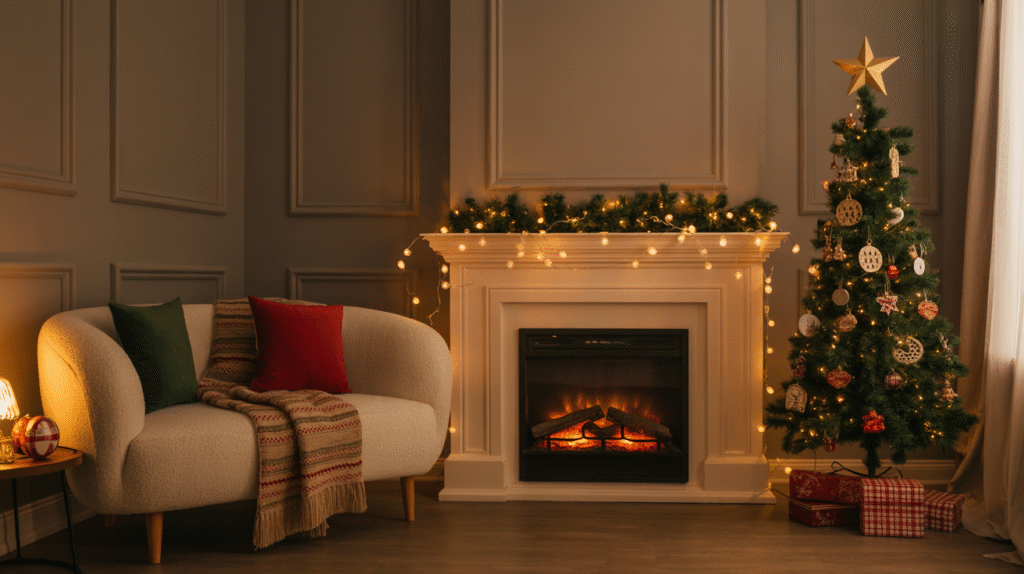
Decorating for Christmas in a small living room requires even more intentionality than general winter decor, as holiday decorations tend toward abundance.
Choose One Focal Point: Rather than decorating every surface, choose one main display—either a small tree, a beautifully decorated mantel, or a window display. Let everything else be subtle supporting elements.
Go Vertical with Your Tree: A slim pencil tree or even a wall-mounted half-tree maximizes vertical space while minimizing floor space. Alternatively, skip the floor tree and create a tabletop tree on a console or side table.
Maximize Windows: Window displays are visible both inside and out without taking up valuable floor or surface space. String lights, hanging ornaments, or greenery garlands make beautiful use of this often-underutilized area.
Hidden Storage for Decorations: Store out-of-season decor under beds, in ottoman storage, or in decorative baskets that double as part of your decor when filled with seasonal items.
Intentional Color Story: Limit your Christmas palette to 2-3 colors that coordinate with your existing decor. This creates cohesion rather than the visual chaos that can make small spaces feel cluttered.
Space-Saving Advent Traditions: Skip the large advent calendar and opt for a hanging fabric version, a tiny desktop version, or even a digital experience that creates holiday magic without physical space requirements.
DIY Christmas Decorations to Transform Your Living Room
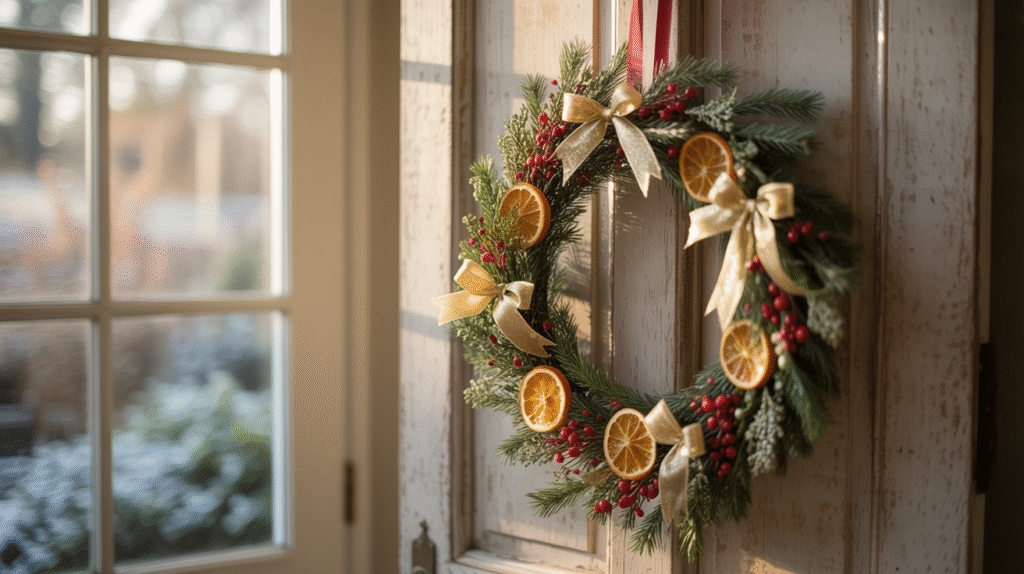
Handmade decorations add personal charm and save money while creating exactly the aesthetic you want. These projects range from beginner-friendly to more advanced, ensuring there’s something for every skill level.
Dried Orange Garland: Slice oranges thinly, dry them in a low oven or dehydrator, then string them with cinnamon sticks and cranberries for a beautiful, fragrant garland that works for both Christmas and winter.
Pinecone Fire Starters: Dip pinecones in melted wax, add a wick, and package them in a rustic basket by your fireplace. They’re functional decor that guests will admire.
Fabric Scrap Garland: Cut strips of cozy fabric (flannel, wool, burlap) and tie them onto a length of rope or ribbon. This no-sew project adds texture and warmth to mantels or banisters.
Painted Wood Slice Ornaments: Use a saw to cut branches into rounds, drill a small hole at the top, and paint simple designs—snowflakes, trees, or winter sayings. String with twine and hang on trees or walls.
Mason Jar Snow Globes: Fill mason jars with epsom salt “snow,” add miniature trees or houses, and top with battery-operated fairy lights for magical luminaries.
Upcycled Sweater Pillows: Turn thrifted wool sweaters into cozy throw pillow covers by simply cutting and sewing them to fit existing pillow inserts. The texture is unbeatable.
Wood Bead Garland: Thread large wooden beads onto jute twine, adding felt balls or tassels between sections. This farmhouse-style garland is endlessly customizable.
DIY Cozy Winter Decor Projects for Your Living Room
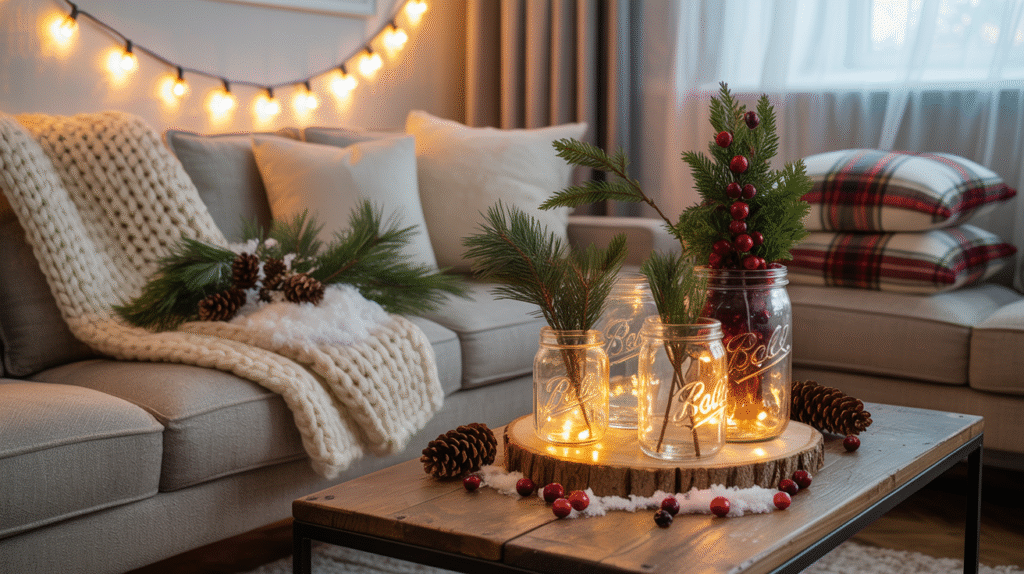
Beyond Christmas-specific decorations, these DIY projects create lasting winter coziness that works through the entire season.
Chunky Knit Throw Blanket: Even if you’re not an experienced knitter, arm knitting or using a simple loom can create beautiful chunky blankets in a weekend. Tutorial videos make this surprisingly accessible.
Custom Photo Wall: Create a gallery wall with family photos in matching frames, printed in black and white for cohesion. This personal touch makes any space feel like home.
Painted Plant Pots: Transform basic terracotta pots with warm white, terracotta, or sage green paint. Group them in different sizes with winter-hardy plants for an instant display.
Rope Basket Upgrade: Take an affordable basket and wrap it with soft rope or thick yarn using hot glue for a custom, expensive-looking storage solution.
Pallet Wood Coffee Table Tray: Sand and stain reclaimed pallet wood, add handles from the hardware store, and create a rustic serving tray perfect for coffee table styling.
Lavender Sachets: Sew simple fabric pouches, fill them with dried lavender, and tuck them among throw pillows and blankets. They add a subtle scent while looking charming.
Macramé Wall Hanging: Beginner macramé tutorials can walk you through creating a beautiful wall hanging that adds texture and bohemian warmth to any space.
Cozy Winter Living Room Inspiration by Style (Modern, Rustic, Farmhouse)
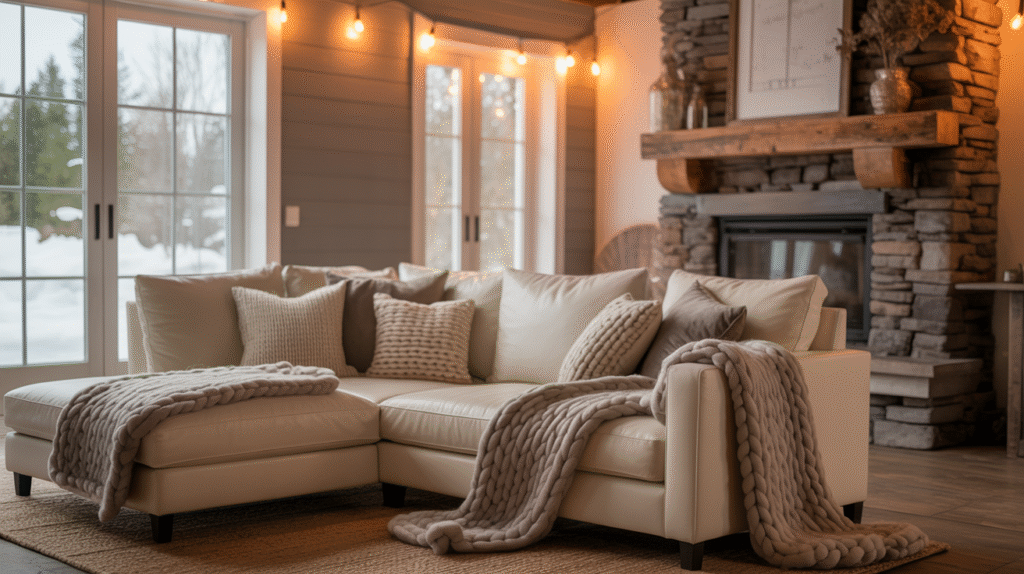
Different design styles approach winter coziness through unique lenses. Understanding these style distinctions helps you create a cohesive look that feels authentically you.
Modern Winter Cozy: Clean lines with soft elements, monochromatic color schemes with warm undertones, minimal but high-quality textures (cashmere, bouclé, smooth leather), strategic pops of metallics in brass or copper, and sculptural rather than busy accessories. Modern cozy proves that simplicity and warmth aren’t mutually exclusive.
Rustic Winter Cozy: Raw and reclaimed wood everywhere, stone or brick accent walls or fireplaces, animal hide or faux fur rugs, leather furniture with visible wear, antler or branch accents, and a color palette pulled directly from nature—browns, greens, grays, and cream. Rustic spaces embrace imperfection and celebrate natural materials.
Farmhouse Winter Cozy: Shiplap or beadboard walls, vintage and new pieces mixed together, functional decor (baskets, crocks, wooden crates), soft neutrals with black accents, painted furniture alongside natural wood, and homespun textiles like quilts and needlepoint pillows. Farmhouse style feels collected, lived-in, and welcoming.
Transitional Winter Cozy: Blends traditional comfort with contemporary simplicity, uses classic furniture in updated colors, balances ornate and simple elements, and appeals to those who want timeless appeal with current relevance.
Bohemian Winter Cozy: Layers upon layers of global textiles, jewel-toned colors and rich patterns, mixed metals and woods, plants everywhere, and an eclectic, collected-over-time feel. Boho cozy is maximalist warmth done right.
Budget-Friendly Cozy Living Room Decor Hacks for Winter
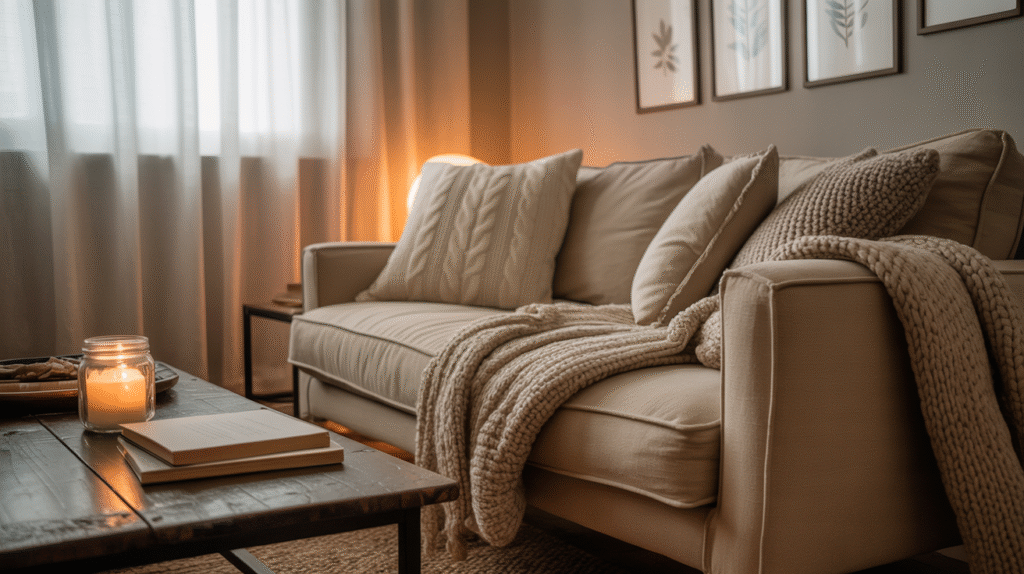
Creating a luxuriously cozy space doesn’t require luxury spending. These clever hacks deliver maximum impact for minimum investment.
Shop Your Home First: Before buying anything new, shop your own home. Move items from other rooms, swap artwork between spaces, and repurpose items in unexpected ways. You’ll be surprised what you already own.
Strategic Color Swaps: Change throw pillow covers instead of buying entirely new pillows. Switch out artwork temporarily. These small color changes transform a space without permanent commitment.
Lighting Transformation: Swap standard bulbs for warm-toned ones, add one new table lamp from a discount store, and introduce inexpensive string lights or candles. Lighting changes are the most cost-effective way to increase coziness.
DIY vs. Buy: Make items that are overpriced at stores (throw pillow covers, simple garlands, painted wood signs) and buy items that are hard to DIY well (quality throw blankets, good candles, warm-toned bulbs).
Off-Season Shopping: Buy winter decor in February and March when it’s heavily discounted, then store it for next year. Buy blankets and flannel sheets in spring. Patience pays off.
Nature as Decor: Forage free winter branches, pinecones, and interesting twigs. Even apartment dwellers can usually find parks with natural elements to ethically collect.
Rearrange Furniture: Moving your furniture layout costs nothing but can completely transform how a space feels. Angle seating toward a focal point, create conversation groupings, or pull furniture away from walls for a cozier arrangement.
Texture Layering: Layer what you have—put that pretty quilt over your sofa back, drape scarves as table runners, stack books to create height in vignettes. Layering costs nothing but creates complexity.
How to Personalize Your Winter Living Room Space
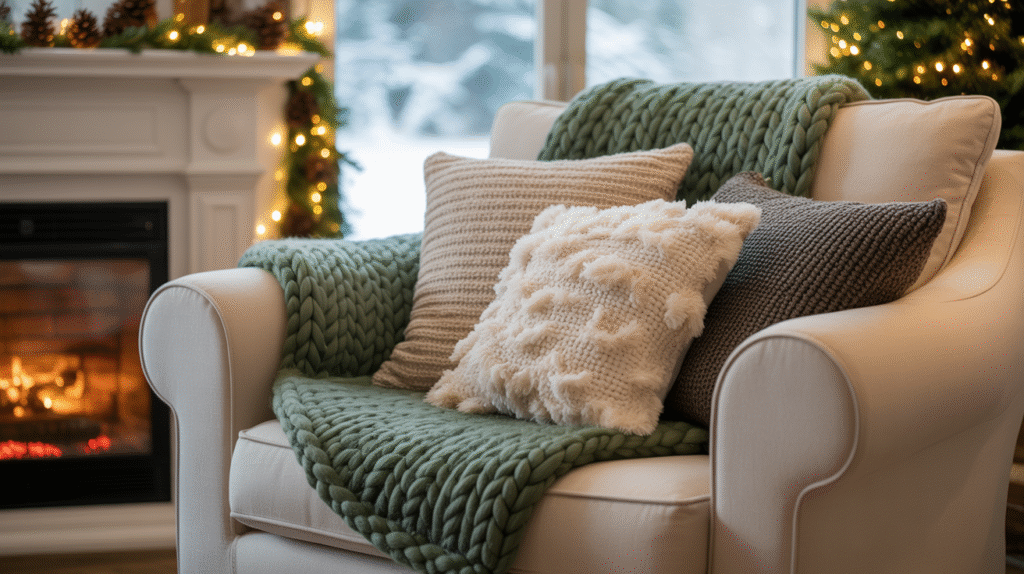
The coziest living rooms aren’t those copied from catalogs—they’re spaces that reflect the people who live there. Personal touches transform a well-decorated room into a beloved home.
Display What You Love: Whether it’s vintage cameras, seashells from memorable vacations, or your grandmother’s teacup collection, displaying meaningful items adds soul to your space. Group collections together for impact rather than scattering them.
Create Family Traditions: Designate a puzzle corner, set up a hot chocolate station with your favorite mugs, or create a reading nook with your childhood books. Spaces designed around how you actually live feel infinitely more inviting.
Incorporate Handmade Items: Whether made by you, your children, or local artisans, handmade items carry energy and story that mass-produced decor cannot replicate. A lumpy handmade pottery vase beats a perfect store-bought one every time.
Tell Your Story: Frame meaningful quotes, display travel photos, or showcase artwork from local places you love. Your living room should hint at who you are and what matters to you.
Sensory Personalization: Beyond visual aesthetics, personalize the sensory experience—your favorite candle scent, a playlist of songs that make you happy, a specific tea you brew on winter evenings. Cozy is as much about feeling as appearance.
Leave Room for Life: The most personalized spaces aren’t perfectly styled 24/7. Leave room for current projects, books you’re reading, and hobbies in progress. A living room should be lived in, not preserved.
Final Thoughts
Creating a cozy winter living room is an ongoing practice rather than a one-time project. As temperatures drop and we spend more time indoors, our spaces should evolve to support our need for warmth, comfort, and connection.
Whether you’re drawn to rustic farmhouse charm, clean modern lines, or eclectic bohemian layers, the principles of winter coziness remain the same: prioritize soft textures, warm lighting, personal touches, and elements that invite you to slow down and savor the season.
Remember that cozy is a feeling, not a checklist. Trust your instincts, prioritize what makes you feel most at home, and don’t be afraid to break design “rules” if something brings you joy.
Your living room should support how you actually live—whether that’s hosting gatherings, enjoying quiet solo evenings, or somewhere in between.
As you implement these ideas, give yourself permission to experiment, evolve, and most importantly, to simply enjoy the sanctuary you’re creating.
Winter is long, but a thoughtfully designed cozy living room makes it something to embrace rather than endure.
Now grab that favorite blanket, light some candles, and enjoy the warm, inviting space you’ve created.

